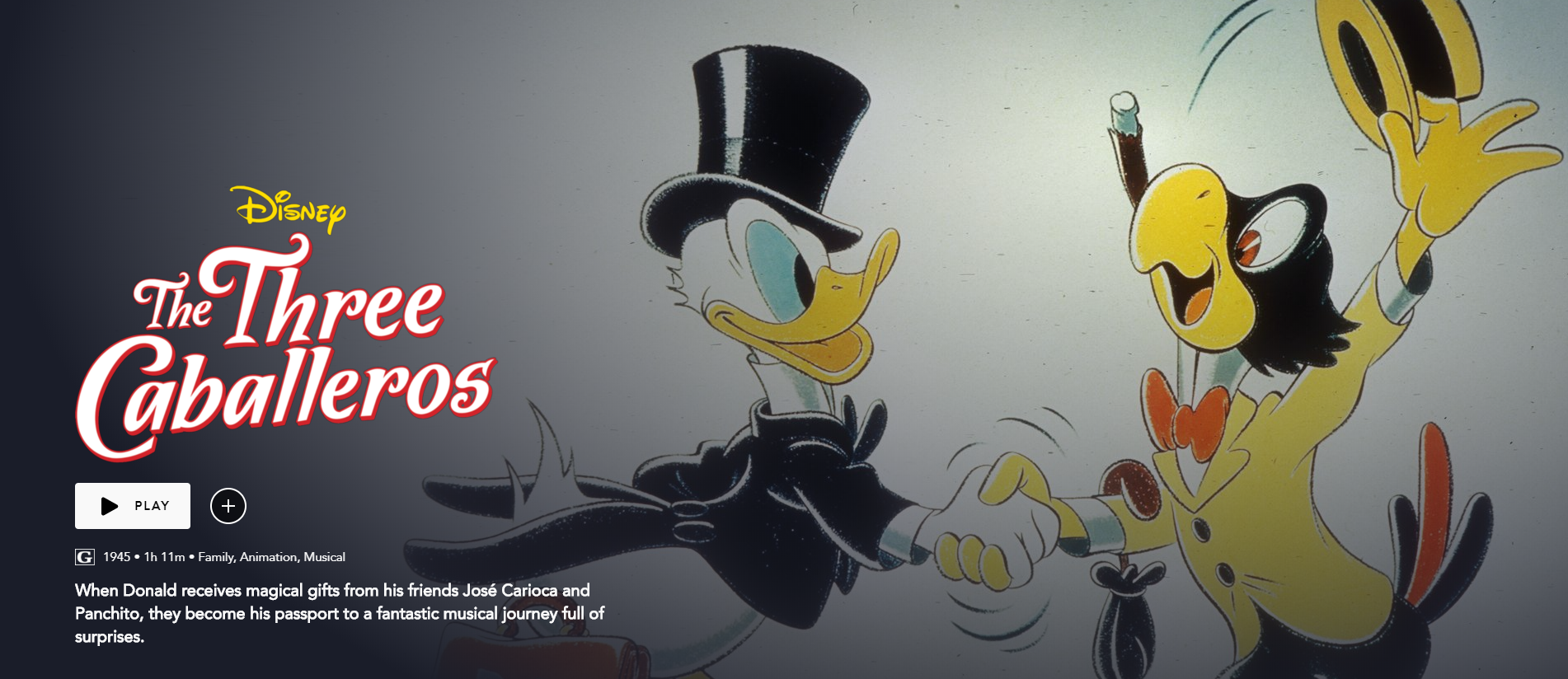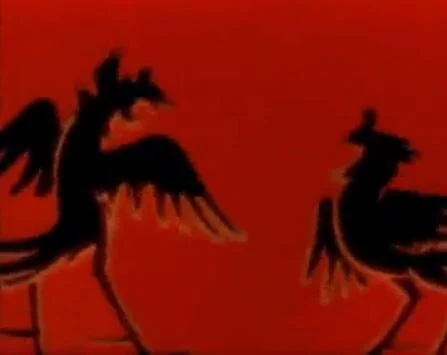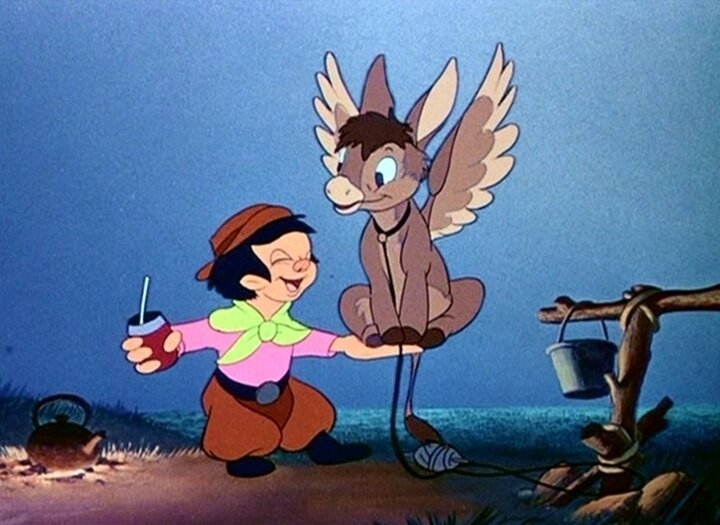Review: The Three Caballeros (DMC #8)
Welcome back, Disnerds! Last night we watched the eighth movie in the Disnerd Movie Challenge, The Three Caballeros. Read on for a quick synopsis followed by our review.
Synopsis
This is another of the war-era films, and it consists of seven segments that are all loosely connected by Donald unwrapping three presents from his friends in Latin America. The first gift is a film projector which shows him a film called “Aves Raras.” This film within the film contains three segments. The first is a cartoon called “The Cold-Blooded Penguin” in which a penguin, sick of the cold and longing for the warmer climes, sets out on a voyage toward South America. This is followed by a showcase of the various birds of South America, most notably the Aracuan bird. The final cartoon on this film projector is “The Flying Gauchito,” the story of a boy (narrated by his older self) who discovers and befriends the most peculiar creature—a winged donkey he calls Burrito.
Donald’s second birthday gift is a pop-up book from Jose which shows off Jose’s favorite place: Bahia (spelled "Baía" in the film). Jose and Donald shrink down and jump into the pages of the book to explore. They dance the samba with some locals, and Donald pines for a woman who sells cookies. When their adventure concludes, they leave the book and move on to Donald’s next present—a new friend, named Panchito. The three give themselves the name “The Three Caballeros” and sing the song by the same name. Panchito then tells Donald about the Christmas tradition of “Las Posadas” and the role the piñata plays before Donald, blindfolded, tries to break his own piñata. Once the piñata is broken, Panchito whisks the three of them to Mexico City on a flying sarape (magic carpet). Here they learn a few different traditional dances, and Donald chases after every woman he sees on a beach. The final two segments of the movie, “You Belong to My Heart” and “Donald’s Surreal Reverie” show Donald entranced by different women as they sing and dance together, at times accompanied by abstract and surreal animations. The film ends with an explosion of firecrackers.
Thoughts Before Watching
Megan: My only memory of The Three Caballeros is the song itself. That clip of animation was included in one of the Disney sing-along videos I used to watch as a kid. I’m pretty sure it was Disney Sing Along Songs: Heigh-Ho. I have no idea what to expect with the rest of this film, but if it’s anything like last week’s movie, Saludos Amigos, I’m a little bit worried this, too, might be boring.
Kevin: The last time I remember putting this movie on, it was more to serve as some background noise while I did other things, so there was only so much I remembered going into it this time around. Like Megan, though, I’m most familiar with the title song thanks to the Sing Along Song movies (man those were wonderful, wish they released them on DVD or Blu-Ray). I’m not expecting to enjoy this any more than I did previously.
Thoughts After Watching
Megan: I’m not quite sure how this film was received when it first came out, but personally I’m kind of thinking maybe Disney didn’t need to make movies during war time? I can see where the artists’ trip to South America referenced in Saludos Amigos most likely influenced much of The Three Caballeros, but so much of the film still feels like a glorified travel log, while other elements feel more like artistic experimentation that perhaps should have been left behind during the editing process—valuable, I’m sure, for the artists to learn and experiment, but not great for entertainment value.
Entertainment is a product of its time…
Kevin: I see Megan’s point about making movies during the war; it’s been nearly 80 years and these films are easily the least remembered, even compared to the ones that preceded them. Still, Disney had its reasons. The studio was contracted to keep making films, especially war propaganda. Its financiers would only provide loans so long as it produced low-budget shorts while the war raged, and until the war ended the majority of the studio’s animation was created for the military.
Additionally, the U.S. Good Neighbor policy led to Disney’s Latin America trip, which inspired this film and Saludos Amigos. Coupled with many employees off serving abroad and many more having gone on strike and quitting the studio, films like this were ultimately a result of having to put in-production features such as Alice in Wonderland and Peter Pan on hold while still giving civilians reasons to go to the movies during wartime. What better way to do this than offer an escape from the dreary wartime worries through vibrant pictures and catchy tunes? In short, life still had to feel “normal.”
…but that doesn’t make it great entertainment.
Kevin: The context doesn’t make this film fun or remotely interesting. In hindsight, these films are more problematic than not. Upon finishing our watch, I had put it on the same level as Saludos Amigos, but when I was writing my notes for this review I realized this is worse. Artistically, the animation is just alright — there’s nothing dull about it, but there’s nothing that stands out either, probably because of the lower budget. The mix of live action and animation is used more frequently here than in Saludos, but it was more annoying and distracting than fun, and doesn’t feel done well. After two films in a row that make heavy use of this effect, I’d rather it just be all live action or strictly cartoon.
There is so much sexism in such a short film.
Megan: While Saludos Amigos mostly didn’t include women, The Three Caballeros includes lots of women—each and every one of them displayed as an object of male desire. Sure, women speak and sing throughout the film, but it fails the Bechdel test because the only time women speak to each other they are talking about Donald Duck. Beyond that, though, I found it increasingly annoying and uncomfortable to watch the animated Donald’s interactions with the live-action women in this film. Let’s start with the woman who sells cookies. Donald immediately falls for her, and it has nothing to do with her cookies. This woman seems to have some power (she sells cookies that I believe she makes, so she’s a business woman, and as she sings and dances she magically commands the animated buildings to dance along with her), and yet the entire segment is more about how Donald and the live-action male characters are fawning over her and trying to win her affections.
Megan: Later, in Mexico City, Donald, Jose, and Panchito fly over a beach where women in bathing suits are lounging or playing (oddly there are no men on this beach—is this beach only open to women?). Donald and his friends then mime shooting at the women as if they’re in a fighter jet (I wish I was joking) while the flying carpet dive bombs the women who flee. Donald then falls onto the beach and begins chasing after every woman in sight, trying to catch them. What’s worse is that the women are portrayed as laughing and having a grand old time while Donald lusts after them. I at least appreciated that the women in turn have a bit of fun at Donald’s expense, blindfolding him and teasing him, but it doesn’t make up for Donald’s antics here—especially since this is supposed to be a kids’ movie. I wonder how many kids in the 1940s were constantly exposed to content like this in various forms and then grew into adults who thought it was okay to treat women this way.
Kevin: I second Megan here. The sequences are not helped thanks to Donald Duck, who is, as always, given the gimmick of being the most unsavory character in every scene. Also, what is it with that one image of two roosters fighting? I get that roosters will fight for many reasons, but one of them could be that they are fighting for a hen’s affection.
Putting that in light of what’s going on in this segment, where just seconds before a bunch of men are goggling at a woman, this particular shot is weird. It seems like it implies men can’t help but lose control and fight when a beautiful woman is around. I can’t help but think of the term “cockblocking,” which is what this looks like regardless if it was intended or not. I didn’t pick up on this when I was kid, but it has a whole new meaning now. Maybe I’m reading/looking too much into this, but this scene was bizarre, and I hope no young boy watching this gets any bad ideas. Fellow men, please don’t fight over women, and certainly don’t act like Donald.
Honorable mention to the penguin and the donkey-bird.
Megan: While the later half of the movie (really everything from Donald’s second present onward) is sexist and dull, I did enjoy the animated shorts in the first part of the film. I’d actually seen clips of that penguin cartoon before as part of the Disney Christmas sing-along videos or compilation videos. I can relate with Pablo the penguin—I, too, find winter somewhat unbearable, which is why I moved back to California after five years on the east coast. He also reminds me a little bit of Olaf since he’s a winter creature who longs for warm weather.
I also appreciated the cartoon about the boy who finds the donkey-bird Burrito. While at times I was a little worried that Burrito was being held against his will, in the end the two seemed like good friends. The animation style here is cute and I like how the boy cons his way into the race and wins (even if he technically cheated by entering a flying donkey).
Kevin: Megan said everything I would have, but I wanted to give my two cents on these two shorts. During our long distance years, I would visit Megan at least once during the winter months. I completely empathize with Pablo’s desires here even if I never actually lived in the cold for long periods of time. For this born-and-raised Californian, summer and warmth is my idea. Move over, Figaro, Pablo is my new spirit animal.
If this film were a TV short consisting only of Pablo and the winged donkey cartoons, this would be so much better.
Verdict
Megan: 1 (can I give this one a zero?)
Kevin: 1
Total: 1
What did you think of this movie? How do you think it holds up (or doesn’t) with today’s audiences? Tell us in the comments!









